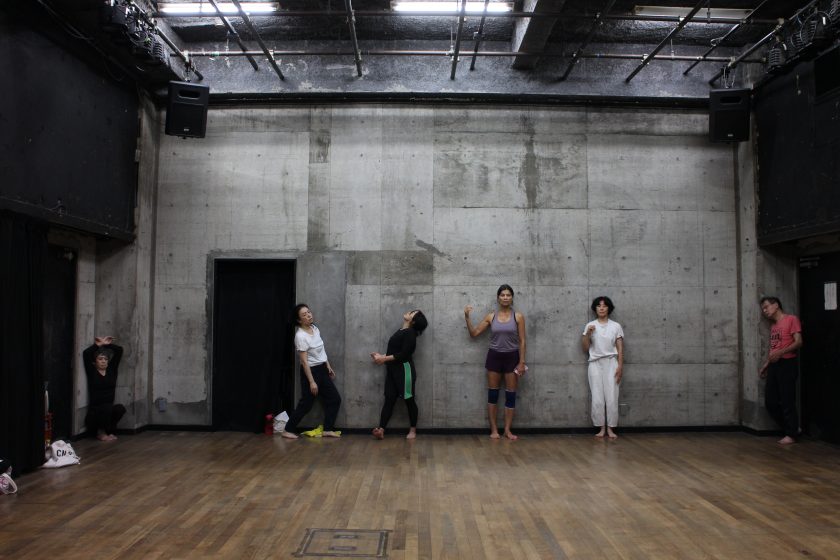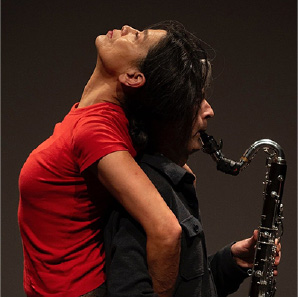Dance WS Faux Pas

Student impressions
The theme of the workshop was “falling.” This was also the theme that Ko Murobushi kept repeating in his dances. In the workshop, we shared the words of Ko Murobushi, experiences of Emmanuelle that served as the turning point which led her to “Múa 1995,” and the choreography in the “falling” part of the work. The participants were given homework to “think about what ‘falling’ meant to them” and were asked to dance their own “falling” on the last day. One participant fell violently over and over in all directions, while another was tugged around by their own life “as if they were handcuffed.” Yet another danced their experience of falling down a flight of stairs, then stood perfectly still on one leg. Some danced to music, inspired by the dances of other participants. There was a dance in which the dancer only sustained a “falling” like they were sinking; they stood on one leg while holding the other as if facing their own pain. There was another dance in which they expressed a situation of being unable to get up from the floor. I decided to face what gravity and upward forces bring to my body. I also was impressed when Emmanuelle underlined how the participants talked about what “falling” meant and took time to share about their own dances in their own words.
Marie Sakamoto
–
Emmanuelle Huynh handed us the essence of faux pas from a variety of physical techniques and work that she has encountered and incorporated into her body during her dancing career. From Iyengar Yoga to a simple combination of body weight on the floor and movement vectors. From Lisa Nelson, a master contact dancer, a choreography that moves between the stability and instability that occurs between the weight of the head and the supporting hand (I’m tempted to call it “solo contact”!). . And a choreographic transposition from the “Múa” dance that Emanuel created during a period in his life when he was at the bottom of his game. The three days of the workshop were spent exploring the suspension between falling and rising again. I recall that the work was temporarily interrupted when an emergency alarm for an earthquake went off. Faux pas may always be with us, a state in which we are suddenly thrown out of the safe zone into another world. It is a state in which we are suddenly thrown out of the safe zone into a different world, and it may always be with us. It was a rich WS where sensations and thoughts spread like waves.
Yuki Furukawa

Fragments
2006 Ko Murobushi WS memo at CNDC Angers
A mummy’s donation.
A treasure trove. A surprise treasure trove of future instincts.
If it is the present, then the present is already an (unexpected) accident = incident.
Everyone will fall for this day.
Everyone will burn their skin; they will tear it.
All of life is about how to fall.
If you fall, you have no choice but to get up again – those who get up most certainly have a history of falling.
Ko Murobushi
Infomation
“Life is about how one falls and gets back up.” This was part of the notes Ko Murobushi wrote in his notebook when he was invited to teach at the Angers National Center for Contemporary Dance. In this workshop, I will be sharing excerpts from some of my works, including “Múa” (1995), “Augures” (2012), and “Nuée” (2021), as I think about the “falling” and “getting back up” of my own existence. Each of them invents a “dance of falling and getting back up” through improvisation and composition combined with my own vocabulary. I am looking forward to seeing all of you there. (Emmanuelle Huynh)
Date
Thursday, August 8 and Friday, August 9
18:30 – 21:30
Venue
Nakano Terpsichore
Profile

Emmanuelle Huynh
Dancer, choreographer, teacher. Working actively with artists from various fields such as sculptors and musicians, Emmanuelle focuses on reconstructing dance from a critical point of view. She has danced for many choreographers such as Dominique Bagouet and Trisha Brown, also collaborating with Hervé Robbe, Odile Duboc, and many others. She has served as artistic director at the National Center for Contemporary Dance (CNDC) in Angers as well as associate artist at Theatre de Nimes from 2018 to 2021, and has been teaching at Beaux-Arts de Paris since September 2016.
